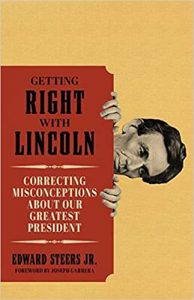Book Review –Getting Right with Lincoln: Correcting Misconceptions about Our Greatest President
 Getting Right with Lincoln: Correcting Misconceptions about Our Greatest President
Getting Right with Lincoln: Correcting Misconceptions about Our Greatest President
By Edward Steers
University Press of Kentucky, 2021, $27.95 hardcover
Reviewed by Richard G. Frederick
Lincoln historiography has been awash with controversy for the last 150 years. Disagreements over his ancestry, relationship with family members, love life, views toward slavery and Blacks in general, conduct of the war and myriad other issues have always informed the Lincoln hagiography.
Varying views of the 16th President formed the subject of Richard N. Current’s The Lincoln Nobody Knows, a classic study published in 1958. Subsequent decades, especially the years around the bicentennial of Lincoln’s birth in 2009, brought a new wave of Lincoln studies, but little resolution to many of the questions surrounding his life. In Getting Right with Lincoln, Edward Steers addresses eight of these controversies, as well as providing a sprightly account of a literary hoax in the late 1920s involving a California woman named Wilma Frances Minor and her cache of alleged correspondence between Lincoln and Ann Rutledge.
Subjects addressed in the book include the character of Lincoln’s father; whether the famous letter to the Widow Bixby commiserating on the deaths of her five sons in the Civil War was written by Lincoln or his secretary John Hay; Lincoln’s love affair with Ann Rutledge; Lincoln’s actions toward the Dakota Sioux following a massacre in Minnesota in August 1862; Lincoln as a “reluctant emancipator”; theories about Lincoln’s health; the controversy over allowing trade in cotton to continue under certain conditions during the war; and the circumstances surrounding West Virginia statehood.
Each subject is treated discretely with a separate essay; each is interesting in its own right, with a conclusion which usually illustrates some truth about historical methods or approaches to the writing of history. For example, in the controversy over the authorship of the Bixby letter, Steers disputes Michael Burlingame’s claim that John Hay was the author of the missive, since a copy of the letter was found in a scrapbook of Hay’s writings at Brown University. Burlingame’s hypothesis was further strengthened by a relatively new technology called “N-gram analysis,” in which probability theory is applied to word sequencing to establish authorship of unknown writings. Steers concludes that the brevity of the letter is problematic for the use of this tool, and concludes that the question is still open, though he clearly favors earlier textual analysis methods which point to Lincoln as the author.
Another chapter, “The Ailing Lincoln,” concerns a different type of scientific methodology applied to history—medical science. Steers examines the notion that Lincoln may have suffered from Marfan’s syndrome, a claim advanced in the early 1960s and adopted by several Lincoln scholars. After presenting several points of refutation, Steers concludes with certainty that, “whatever Lincoln’s medical problems were, Marfan’s syndrome was not among them.” He then goes on to consider other claims about Lincoln’s health, including a rare form of cancer, mercury poisoning, syphilis, smallpox, melancholia, and brucellosis, which may well have caused Lincoln’s mother’s death. Throughout the chapter, Steers mainly cautions against attempting medical (or psychological) diagnosis while looking back a century-and-a-half into the past.
In the wide universe of Lincoln scholarship, Getting Right with Lincoln is not an essential work. Neither is it inconsequential, however, and it deserves a wide readership by academic historians, students of history, and general readers. Written in a clear and concise manner, the book serves as a reminder of some of the pitfalls of “doing history.” Obviously, historians should make use of research in scientific and social scientific disciplines to inform their work, but examples in the chapters mentioned above serve as a reminder that caution should be the hallmark of historians venturing into these fields. In another chapter, concerning the character of Lincoln’s father, Steers discusses the reliability of sources, both from Lincoln’s time and later historical accounts, leading to his observation that scholars often look at the same sources but interpret them in different ways.
“While we historians may get our facts right, too often it is our conclusions that are wrong,” he notes, in what may be characterized as the book’s major theme.

Thanks for this. Edward Steers has devoted considerable attention to the Lincoln Assassination: my copy of his Assassination Encyclopedia is severely dog-eared and nearly double its original thickness due inclusion of additional facts and unexpected connections uncovered over the years. I would imagine that in pursuit of information IRT one of his main subjects, Abraham Lincoln, details not directly relevant to the assassination revealed themselves and found a home in this 2021 work. And sometimes, the “unexpected connections” can be the most interesting…
Greatest president? Lincoln violated the Constitution and the Bill of Rights like no other president had before him and after him. What good is a government that ignores the protections our Constitution and Bill of Rights afford the American people?
I know… it’s hard for some to believe he even deserves a place on Mount Rushmore, despite Saving the Union; and emancipating the slaves. But never fear: we have an example of a President who did NOT respond to Southern aggression against the U.S. Flag (carried high on the mast of the Star of the West in January 1861.) Followed all the rules and allowed his hands to be tied. And notice where THAT man is ranked among the Presidents…